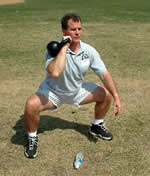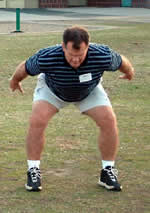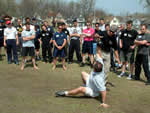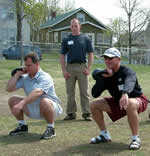
Ethan Reeve, Strength and Conditioning Coach at Wake Forest University since 2001, began his athletic career as a wrestler. He was a two-time N.C.A.A. All-American and four-time Southeastern Conference champion in wrestling, and coached the sport on the high school and college level for 18 years. Certified through the United States Weightlifting Federation and the National Collegiate Strength and Conditioning Coaches Association, Reeve strength trained the U.S. Women's Rowing team, which won four gold medals and one silver at the 1995 World Championships. He received his Russian Kettlebell Challenge certification in April of 2003.
Dragon Door: Can you talk a little about your background, and how you've incorporated kettlebells into your training at Wake Forest?
Ethan Reeve : My sport, as an athlete, was wrestling. I've always been into strength training, ever since I was in elementary school. I was a wrestling coach for several years. However, since the sport of wrestling has lost so many programs at the collegiate level I decided to change occupations. Strength training was my best option. So, when I was about 35, I totally changed my occupation and became a strength coach.
I've always had an interest in kettlebells, even when I was a wrestler back in the 70's, but no one had them in the United States. When Pavel came out with them here in the United States we immediately bought them up. We have eight pair of every weight of the 18 lbs, 36 lbs, 53 lbs, and 72 lbs. and we also have four pair of the 88 lbs. This next year we plan on buying eight pair of the 26 lbs for our female athletes.
I have studied the KB videotapes and books. We also had homemade kettlebells for a while-they didn't work very well. Lifts that one did with kettlebells we performed with dumbbells. However, the kettlebells are a much better product for the one-arm quick lifts and overhead pressing lifts.
I work with or oversee all the athletes here at Wake Forest University-it's about 400 athletes. We try to maximize the athletic potential of every athlete we train. We start by developing their athleticism. We can't guarantee that we're going to win in football, basketball, or any sport for that matter. What we try to do is to develop better athletes. From that point forward, our sport coaches will take care of their sport skills. We train our athletes to be athletic, that's why we do a lot of barbell Olympic-type lifts…power cleans, hang cleans, clean-and-jerks, squat cleans, front squats, back squats and lunges. The barbell is a great way to train, but you also want to develop that core body, which is a big part of our philosophy, in a different way. Your upper quadriceps, upper hamstrings, gluteals (butt muscles), lower back, abdominals and obliques are all part of this core body. If you want to attack your core body in a different way, you have to train it differently. We do kettlebells in conjunction with the squatting-type movements and the Olympic-type lifting movements. We do the one-arm kettlebell lifts, and we've found them to be very effective because it develops the core in a much different way. So when we use kettlebells, we only use one hand; we will do… two-arm swings to warm up, but we focus on doing one-arm swings, one-arm snatches, one-arm cleans, one-arm presses and one-arm clean-and-jerks.
D.D. : Why use just one arm?
E.R. : It's like this: If you grab two kettlebells, and you walk with them, there's that seesaw, teeter-totter effect. The resistance comes straight down, because the weight in your right hand is balanced by the weight in your left. If you have one kettlebell on just the one side, then what happens? Your muscles have to work on that opposite side to stabilize that core body. So, if I've got a kettlebell in one hand, and I've placed it on my shoulder, like Pavel shows how to press up, then when the kettlebell is down in the lowest part of the press to all the way through to the top of that press you're developing that core body in a much different way than if you used two kettlebells, or if you did a barbell press with two hands.
Actually, we've found that one-arm work and one-legged work to be more functional for sport. If you look at tennis players, they'll occasionally hit backhands with two hands, but generally, they hit with one hand. And most athletes throw a ball with one hand. A basketball player makes a jump shot or a wrestler does a fireman's carry usually with one hand. This is what happens in sport, and I think it's worthy to strength train both two-arm and one-arm lifts. When Pavel has two kettlebells and he's doing a one-legged dead lift-that develops that core body in a much different way than if you did this with two feet on the ground, and that's actually what happens more frequently in sport. When you're running, you always put one foot in front of the other and you must balance on one foot much of the time in sport skills.
D.D. : Why is the core so very important?
E.R. : If you'll take your body and break it down into three parts-let's say your mid-thighs (front and back) down to your feet: that's your lower body. Then from your rib cage up through your head including your arms: that's your upper body. Well, that middle part of your body is the essence of what makes an athlete great.
If you look at great athletes, and you look at not only their strength, but their power, flexibility and balance while in motion-that is what makes a great athlete great. If you look throughout history-look at the statues of the Greek gods and look at the center portions of their bodies and their strength development. Also look at the great athletes of today-same sort of development. Now, there are some guys with big bellies, but generally they want to be strong, powerful and flexible in the core of their bodies.
The kettlebells develop the body in a different way. You're going to develop that core body when you do squats, lunges, cleans, full-contact twists (we call it the wrestler twist) that Pavel's got in one of his books. You're developing that torso rotational strength and power that's very important in sport when training with the wrestler twist.
Most sport skills like batting, throwing, passing, swinging, wrestling…just about everything you're going to do in sport is with torso rotation. That core body is the essence of what makes the great athlete great. And if an athlete doesn't have the flexibility, strength and the power-not just the size…the size is not really the key, it's the strength, power, flexibility, and balance (and especially balance while in motion) he will not be able to maximize his athletic potential. It's the most important area to develop. And the core body is best developed, for athletes, by training in the standing position.
D.D. : You had talked about how KBs had enhanced the performance of the people you train. Is that true?
E.R. : Yeah. We've been very fortunate. In football, in the last two years that we've used the kettlebells, we've had two winning seasons in a row, and that's not been done since the 1985-86 seasons here at Wake Forest. Our men's basketball team, which religiously uses kettlebells, won the ACC regular season, which had not been done since 1962. Our soccer team was ranked number one in the country all year long. Our Field Hockey team won the N.C.A.A. championships this season. Our women's basketball teams, track team, both our men and women's tennis teams, women's cross country which won the ACC and placed 9th in the N.C.A.A.-just about every team that we have, all of our athletes uses the kettlebells.
D.D. : So nothing has changed except the addition of kettlebells to the training?
E.R. : Well, no, some sport coaches have changed, and the strength coaches have changed. We added the kettlebells into our strength training philosophy instead of using dumbbells for those lifts. All of these elements in conjunction have made the difference. There's not any one thing that's made that difference, but we feel that the kettlebells have had a lot to do with our success.
I'm just very impressed with kettlebells. I like them. It gives the kids great variety, and our strength coaches great variety in designing programs for their athletes. Kettlebells really help our athletes develop their athleticism, and we're going to continue doing them. In fact, we're going to purchase some more this coming year. We're going to buy eight pairs of the 26-pounders.
D.D. : When you implemented kettlebells into your program, did you run into any opposition?
E.R. : Yeah, the kids. The athletes didn't quite understand it at first, until they started doing them. And then when they started doing the kettlebells, they felt the difference. And there is a difference.
D.D. : You've mentioned "your philosophy" a couple of times here. What exactly is that philosophy?
E.R. : Since we've been here, we've incorporated our philosophy, and part of that philosophy is kettlebells. This is a philosophy that I have developed over twenty-five years ago when I was a wrestler back in the 1970's at the University of Tennessee. The core body development is number one on the list. Number two is to train in a standing position. Number three is that an athlete needs to train using "athletic lifts."
When you do an athletic movement or skill, in competition or practice, what you incorporate is a lot of joints, tendons, ligaments, and muscles. And this is done in a coordinated and explosive manner. Even though you can't perfectly emulate a sport skill by using kettlebells or barbells or whatever, you still can do lifts that incorporate that coordination and the use of all those tendons, ligaments, joints and muscles. So what we want to do is emphasize the core body while we also train the whole body using the most muscles and joints working together with "athletic" movements.
We do not believe in doing a lot of isolation-type movements in our team workouts. We believe in getting a lot of the joints and muscles working together. That's what I mean by athletic-type lifting, and that's a big part of our philosophy.
Another part of our philosophy is that we train our athletes together as a team. So our whole teams go through this training together. When football works out, football works out together. Let's say soccer comes in, soccer comes in together. Baseball, they train together.
Another thing is that we like short, intense workouts. We like our workouts to last, out of season, no more than 45-60 minutes; and in-season, no more than 20-30 minutes. And that's why we buy the volume of barbells, and bumper plates, platforms and kettlebells that we do. We feel that it's important to be very economical with our time. So, we come in and work short in time and intensity. Get 'em in and get 'em out! This is our philosophy.
One of the most important part of our philosophy deals with the "champion's attitude". We, as strength coaches, will never make an athlete into a champion. We will never be able to prevent an athlete that has the desire to excel from being a champion. So, what we do is encourage the champion's attitude. Champions will always make a sacrifice and do extra workouts and go beyond what is required of them. We don't want to take away that impulse so we will leave a little bit in our athletes during the team workouts while encouraging the extra workouts. We want to encourage some individuality and creativity on the part of the champion. We want them to take some ownership in their success. We, as strength coaches, will never take credit for an athlete's success. That champion made a "concrete" decision to become a champion.
D.D. : Any last thoughts?
E.R .: You can get by using just the barbell or just the kettlebells, but I think the two of them together in conjunction, and learning to train with them together intelligently, and not overdoing it, is a great way to train the athletes to be more athletic. And that's the whole key, to maximize their athletic potential.



